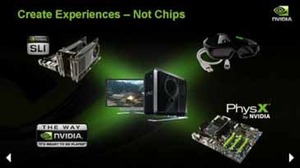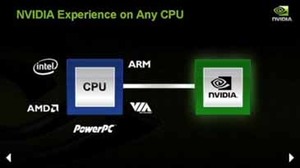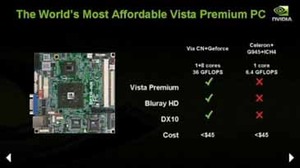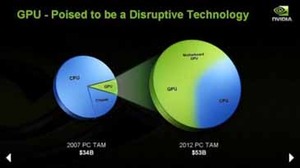It's about the experience
Nvidia covered a lot of topics during the six hours that the company's execs spent in front of analysts and it was time for Nvidia's CEO Jen-Hsun Huang to take centre stage again to summarise his vision for his company's future.Just like the Intel keynotes on the second day, Huang said that "It's not just about the chips, it's not just about the software, it's not just about the middleware – it's about how all of that comes together."
He says that Nvidia's goal is and always will be to build something amazing for the user before pointing out that Nvidia works with all of the major CPU vendors—not just AMD and Intel. "Make sure you develop something that's a holistic experience and once you make that capability possible, why do you limit that capability based on the CPU choice that has been made?" he asked, rhetorically.
"We want to make sure that the Nvidia experience is possible on any processor that the customer wants to choose. . . . For many of these applications, visual computing is the point. Enjoying the multimedia experience is the point – it's not always about the microprocessor. So finding a balanced approach to designing things allows you to bring amazing capabilities to very affordable price points – and there's just no reason why you can't do that," he answered.
Huang then revealed what he claims to be the world's most affordable Vista Premium PC – it's a VIA CN 'Isaiah' CPU with a GeForce motherboard GPU on a tiny PCB. This, he claims, can deliver smooth Blu-ray movie playback in HD and also DirectX 10 graphics for under $45 US. Pretty impressive and it could find its way into some low-cost 'nettop' machines later this year – we'll be keeping an eye on that one for definite.
Thoughts
Nvidia's CEO and President made a lot of very good points during the six hours he spent on stage talking about his vision for the future and—like every time I've spoken to the man—you have to feel that he believes in everything that he says. It's as if it all comes from the heart and his diatribe was nothing more than the passion he has for this industry coming out... in the bucket load. Whether or not we believe everything that spurts out of his mouth is another thing altogether though.There's no denying the magnitude of the task that Intel has embarked upon with Larrabee—not only has the company got to develop an architecture that's many times more powerful than the CPUs it is shipping to customers today, but it's also got to get the software support right and of course the drivers – something that Intel hasn't been too hot on in the past. And all of this goes without mentioning the fact that Intel has one of the most passionate and fired up competitors in the industry waiting in the wings to unleash its version of hell.
Nvidia has spent more than $1 billion US on R&D each year for the past few years and the rate at which it continues to innovate will not slow down – knowing Huang, it will only accelerate. But that doesn't take into consideration the size of the task ahead for Nvidia, because it too has a long and drawn out battle ahead of it. Intel is many times bigger than Nvidia and the company knows that it has to outsmart and out-innovate its bigger competitor to stay alive. That's nothing new—delivering something that adds value has always been required—but never before has Nvidia been up against a competitor as formidable as Intel. It's a real case of David vs. Goliath here.
Of course, it's clear to us that Nvidia has been sandbagging releases in the past year or so, but that doesn't mean its product development has slowed. Huang revealed that there will be a new architecture released "in the very near future" that will be known as Tesla2 and there have been several hints in the presentations at new features that we're likely to see included in that architecture.
Huang doesn't seem fazed by Intel's push into his territory at the moment, but he said he remembers the scars he got following the release of the GeForceFX architecture—and said he still has some of them—so you get the feeling Nvidia is going to be as well prepared as it possibly can be for this battle. And it really needs to be this time around, too.
This is just the start of the battle and there's a long way to go yet – it's going to be an interesting next five or so years.

MSI MPG Velox 100R Chassis Review
October 14 2021 | 15:04













Want to comment? Please log in.